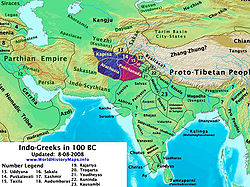"ഇന്തോ-ഗ്രീക്ക് സാമ്രാജ്യം" എന്ന താളിന്റെ പതിപ്പുകൾ തമ്മിലുള്ള വ്യത്യാസം
Luckas-bot (സംവാദം | സംഭാവനകൾ) (ചെ.) യന്ത്രം ചേർക്കുന്നു: sh:Indo-Grčko Kraljevstvo |
(ചെ.) യന്ത്രം ചേർക്കുന്നു: vi:Vương quốc Ấn-Hy Lạp |
||
| വരി 77: | വരി 77: | ||
[[sh:Indo-Grčko Kraljevstvo]] |
[[sh:Indo-Grčko Kraljevstvo]] |
||
[[simple:Indo-Greek Kingdom]] |
[[simple:Indo-Greek Kingdom]] |
||
[[vi:Vương quốc Ấn-Hy Lạp]] |
|||
[[zh:印度-希臘王國]] |
[[zh:印度-希臘王國]] |
||
05:28, 9 സെപ്റ്റംബർ 2010-നു നിലവിലുണ്ടായിരുന്ന രൂപം
ഇന്തോ ഗ്രീക്ക് സാമ്രാജ്യം | |||||||||
|---|---|---|---|---|---|---|---|---|---|
| ബി.സി.ഇ. 180–10 | |||||||||
 Indo-Greek Kingdoms in 100 BC. | |||||||||
| തലസ്ഥാനം | Alexandria in the Caucasus Sirkap/Taxila Sagala/Sialkot Pushkalavati/Peucela | ||||||||
| പൊതുവായ ഭാഷകൾ | ഗ്രീക്ക് (ഗ്രീക്ക് അക്ഷരമാല) പാലി (ഖരോഷ്ടി ലിപി) സംസ്കൃതം, പ്രാകൃതം (ബ്രഹ്മി ലിപി) അരമായ ഉപയോഗിച്ചിരിക്കാനും സാദ്ധ്യതയുണ്ട് | ||||||||
| മതം | ബുദ്ധമതം പുരാതന ഗ്രീക്ക് മതം ഹിന്ദുമതം സൊരാസ്ട്രിയൻ മതം | ||||||||
| ഗവൺമെൻ്റ് | Monarchy | ||||||||
• 180-160 BC | Apollodotus I | ||||||||
• 25 BC-10 | Strato II | ||||||||
| ചരിത്ര യുഗം | Antiquity | ||||||||
• സ്ഥാപിതം | ബി.സി.ഇ. 180 | ||||||||
• ഇല്ലാതായത് | 10 | ||||||||
| |||||||||
ഇന്തോ-ഗ്രീക്ക് സാമ്രാജ്യം (ചിലപ്പോൾ ഗ്രീക്കോ-ഇന്ത്യൻ സാമ്രാജ്യം എന്നും അറിയപ്പെടുന്നു[1]) ക്രിസ്തുവിനു മുൻപുള്ള അവസാനത്തെ രണ്ട് നൂറ്റാണ്ടുകളിൽ വടക്കേ ഇന്ത്യയുടെയും വടക്കുപടിഞ്ഞാറേ ഇന്ത്യയുടെയും പല ഭാഗങ്ങളിലും വ്യാപിച്ചുകിടന്നു, മുപ്പതിലേറെ ഹെല്ലനിക രാജാക്കന്മാർ ഈ സാമ്രാജ്യത്തെ ഭരിച്ചു,[2] പലപ്പോഴും ഇവർ പരസ്പരം യുദ്ധം ചെയ്തു.
ബാക്ട്രിയ ആസ്ഥാനമാക്കി ഭരിച്ചിരുന്ന ഗ്രീക്കോ ബാക്ട്രിയൻ രാജവംശത്തിലെ യൂത്തിഡെമസിന്റേയും പുത്രൻ ദെമെത്രിയസിന്റേയും സാമന്തരായി ഹിന്ദുകുഷിന് കിഴക്കും തെക്കുമായി ഭരണം നടത്തിയിരുന്ന ഗ്രീക്ക് വംശജരായ ഈ രാജാക്കന്മാർ, ബാക്ട്രിയയിൽ യൂത്തിഡെമസ് അട്ടിമറിക്കപ്പെട്ട് പുറത്താക്കപ്പെട്ടതോടെ സ്വതന്ത്രഭരണം നടത്താനാരംഭിക്കുകയായിരുന്നു[3].
ആരംഭം
ക്രി.മു. രണ്ടാം ശതകത്തിന്റെ ആരംഭത്തിൽ ഗ്രീക്കോ-ബാക്ട്രിയൻ രാജാവായ ഡിമിട്രിയസ് ഇന്ത്യ അതായത് ഹിന്ദുകുഷിന് തെക്കുവശം ആക്രമിച്ചപ്പോഴാണ് ഈ സാമ്രാജ്യം സ്ഥാപിതമായത്. ബാക്ട്രിയയിലെ യൂത്തിഡെമസിന്റെ പതനത്തോടെ ഇന്ത്യയിലെ ഗ്രീക്കുകാർ പിൽക്കാലത്ത് ബാക്ട്രിയ (ഇന്നത്തെ അഫ്ഗാനിസ്ഥാൻ, ഉസ്ബെക്കിസ്ഥാൻ എന്നീ രാജ്യങ്ങളുടെ അതിർത്തിയിൽ) തലസ്ഥാനമാക്കിയ ഗ്രീക്കോ-ബാക്ട്രിയൻ സാമ്രാജ്യത്തിൽ നിന്നും വേർപെട്ടു. ഇന്തോ-ഗ്രീക്ക് സാമ്രാജ്യം എന്ന പദം പല രാജവംശങ്ങളെയും ലഘുവായി വിവക്ഷിക്കുന്നു. പാകിസ്താനിലെ പഞ്ജാബ് പ്രദേശത്തിന്റെ കിഴക്കേ അറ്റത്തുള്ള തക്ഷശില[4], പുഷ്കലാവതി, സഗാല [5] തുടങ്ങിയ പല നഗരങ്ങളും ഈ കാലത്ത് നിലനിന്നു. ഈ നഗരങ്ങൾ അവയുടെ പ്രതാപകാലത്ത് പല രാജവംശങ്ങളുടെയും വാസസ്ഥലമഅയിരുന്നു. ടോളമിയുടെ ജ്യോഗ്രഫിക്കയും പിൽക്കാല രാജാക്കന്മാരുടെ നാമകരണവും അനുസരിച്ച്, തെക്കിലുള്ള തിയോഫലിയ എന്ന സ്ഥലവും ഈ സാമ്രാജ്യത്തിന്റെ ഭാഗമോ സാമന്തരാജ്യമോ ആയിരുന്നു.
രാജാക്കന്മാർ
അപ്പോളോഡോട്ടസ് ഒന്നാമൻ, മെനാൻഡർ എന്നിവരാണ് ഇന്തോ ഗ്രീക്ക് രാജവംശത്തിലെ പ്രധാനപ്പെട്ട രണ്ടു ഭരണാധികാരികൾ. മിലിന്ദ പൻഹ (Milinda panha) എന്ന പാലിഭാഷയിൽ രചിക്കപ്പെട്ടിട്ടുള്ള ഒരു ബുദ്ധഗ്രന്ഥത്തിൽ പ്രധാനകഥാപാത്രമായി മെനാൻഡർ ചിത്രീകരിക്കപ്പെടുന്നുണ്ട്. പെഷവാറിന് വടക്കുപടിഞ്ഞാറ് ബജോറിൽ നിന്നും ലഭിച്ചിട്ടുള്ള പ്രാകൃതഭാഷയിൽ ഖരോശ്ഥി ലിപിയിലുള്ള ശിലാലിഖിതങ്ങളിലും മെനാൻഡർ പരാമർശിക്കപ്പെടുന്നുണ്ട്[3].
സംസ്കാരം
ഒരേ സാംസ്കാരികാടിത്തറയിൽ നിന്നുള്ളവരായിരുന്നെങ്കിലും ഇന്തോ ഗ്രീക്കുകാർക്ക്, ഗ്രീക്കോ ബാക്ട്രിയരിൽ നിന്നും വ്യത്യസ്തമായ ഒരു സംസ്കാരം ഉടലെടുത്തു. ഗ്രീക്കോ ബാക്ട്രിയരുടെ നാണയങ്ങൾ തൂക്കത്തിന്റെ കാര്യത്തിൽ ആറ്റിക് മാനദണ്ഡം പുലർത്തുന്നതും ഗ്രീക്ക് ദേവന്മാരേയും, ഗ്രീക്ക് അക്ഷരങ്ങളും ആലേഖനം ചെയ്യപ്പെട്ടതായിരുന്നെങ്കിൽ ഇന്തോ ഗ്രീക്കുകളുടെ നാണയങ്ങൾ തൂക്കത്തിന്റെ കാര്യത്തിൽ ഇന്ത്യൻ മാനദണ്ഡമാണ് പുലർത്തിപ്പോന്നത്. ഇവയിൽ ഗ്രീക്കിനു പുറമേ പ്രാകൃതഭാഷയും ഇടം കണ്ടെത്തിയിട്ടുണ്ട്. മൗര്യന്മാരുടെ ചതുരാകൃതിയിലുള്ള ചെമ്പുനാണയങ്ങളുടെ മാതൃകയിലുള്ള നാണയങ്ങളും ഇന്തോഗ്രീക്കുകാർ പുറത്തിറക്കി. ബുദ്ധസ്തൂപം, വിഷ്ണു എന്നിങ്ങനെ ബുദ്ധ-ഹിന്ദുമതവിശ്വാസത്തിന്റെ പ്രതീകങ്ങളും ഇന്തോഗ്രീക്കുകാരുടെ നാണയങ്ങളിൽ ആലേഖനം ചെയ്യപ്പെട്ടു[3].
അവലംബം
- ↑ As in other compounds such as "Franco-Canadian", "African-American" , "Indo-European" etc..., the area of origin usually comes first, and the area of arrival comes second, so that "Greco-Indian" is normally a more accurate nomenclature than "Indo-Greek". The latter however has become the general usage, especially since the publication of Narain's book "The Indo-Greeks".
- ↑ Euthydemus I was, according to Polybius11.34, a Magnesian Greek. His son, Demetrius I, founder of the Indo-Greek kingdom, was therefore of Greek ethnicity at least by his father. A marriage treaty was arranged for the same Demetrius with a daughter of the Seleucid ruler Antiochus III (who had some Persian descent). Polybius 11.34. The ethnicity of later Indo-Greek rulers is less clear ("Notes on Hellenism in Bactria and India". W. W. Tarn. Journal of Hellenic Studies, Vol. 22 (1902), pages 268–293). For example, Artemidoros (80 BC) may have been of Indo-Scythian ascendency. Some level of inter-marriage may also have occurred, as exemplified by Alexander III of Macedon (who married Roxana of Bactria) or Seleucus (who married Apama).
- ↑ 3.0 3.1 3.2 Voglesang, Willem (2002). "8 - The Greeks". The Afghans. LONDON: Willey-Blackwell, John Willey & SOns, Ltd, UK. pp. 132–134. ISBN 978-1-4051-8243-0.
{{cite book}}: Cite has empty unknown parameter:|coauthors=(help) - ↑ Mortimer Wheeler Flames over Persepolis (London, 1968). Pp. 112 ff. It is unclear whether the Hellenistic street plan found by Sir John Marshall's excavations dates from the Indo-Greeks or from the Kushans, who would have encountered it in Bactria; Tarn (1951, pp. 137, 179) ascribes the initial move of Taxila to the hill of Sirkap to Demetrius I, but sees this as "not a Greek city but an Indian one"; not a polis or with a Hippodamian plan.
- ↑ "Menander had his capital in Sagala" Bopearachchi, "Monnaies", p.83. McEvilley supports Tarn on both points, citing Woodcock: "Menander was a Bactrian Greek king of the Euthydemid dysnasty. His capital (was) at Sagala (Sialkot) in the Punjab, "in the country of the Yonakas (Greeks)"." McEvilley, p.377. However, "Even if Sagala proves to be Sialkot, it does not seem to be Menander's capital for the Milindapanha states that Menander came down to Sagala to meet Nagasena, just as the Ganges flows to the sea."
